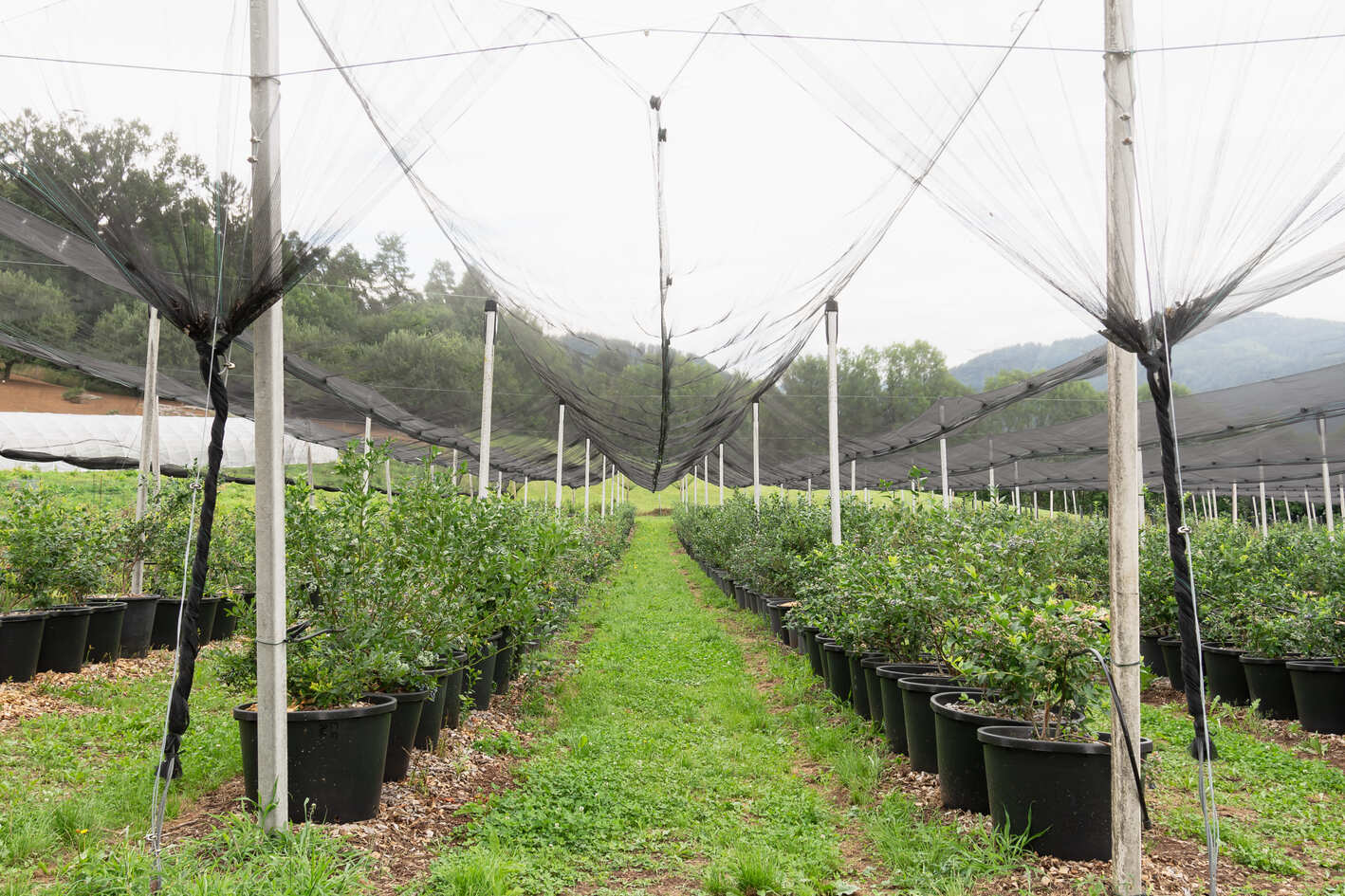Blueberries are sweet, nutritious, and—unfortunately—very tempting to birds and pests. Whether you’re growing them in a home garden or managing a commercial farm, unprotected blueberry bushes often become easy targets for robins, fruit flies, and other hungry visitors. Add spring storms or harsh sun into the mix, and your harvest can quickly suffer.
That’s why more growers are turning to blueberry netting. The right net not only keeps birds and insects away but also helps protect your plants from wind and heavy rain. In this guide, INSONSHADE will first walk you through the common threats to blueberries and the types of netting used to deal with them. Then we’ll show you how to choose the right net based on material, mesh size, and cost—and finally, how to install it effectively, whether you’re working with a backyard patch or a full-scale farm.
Understanding Blueberry Threats and How Netting Works
Choosing the right netting starts with understanding what you’re protecting your blueberries from. As we mentioned earlier, birds, pests, and weather all pose serious risks throughout the growing season. But what exactly are these threats, and how do they damage your crop?
Let’s take a closer look at the main enemies of blueberries:
1. Birds: Sneaky, Fast, and Always Hungry
Ripening blueberries attract birds like magnets—especially robins, starlings, and blackbirds. These birds can spot a ripe bush from far away and swoop in for a feast, often cleaning out entire plants in a matter of hours. They don’t just eat the berries—they peck, scatter, and damage even the unripe ones, reducing your total yield. That’s where bird netting becomes essential. With mesh openings typically around 1/2 inch (1.27 cm), it keeps birds out while allowing sunlight, air, and rain to pass through—protecting your crop without blocking nature.

Anti-bird netting for blueberry
2. Insects: Small but Destructive
Just as the berries begin to plump, here come the pests—blueberry maggots and fruit flies being the most common. They lay eggs inside the fruit, ruining it from the inside out. These pests are especially hard to catch early, and once they spread, they’re tough to stop without resorting to chemicals. In such cases, fine-mesh insect netting offers a safe and effective alternative. With much smaller openings than bird netting, it acts as a physical shield against some bugs, ideal for organic or chemical-free growing.
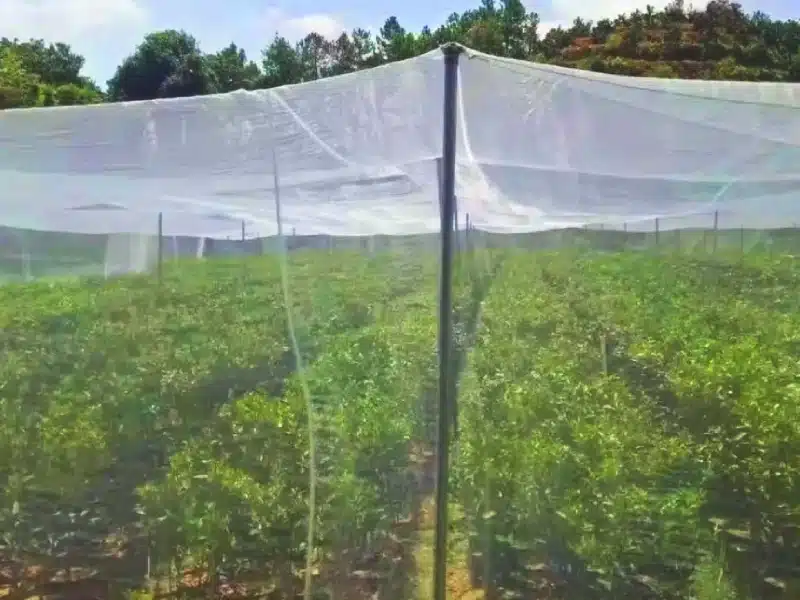
Anti-Insect Netting
And it’s not just living threats—weather also plays a role. Spring winds can knock flowers off before they pollinate. Heavy rain during bloom can damage delicate blossoms. Even intense sunlight can stress the plant or scorch unshaded fruit. To soften these effects, some growers turn to shade netting. It helps reduce light intensity and heat stress, especially in warmer climates or high-sun locations.
How to Choose the Right Blueberry Netting
Now that we’ve looked at what you’re protecting your blueberries from—and the types of netting available—it’s time to talk about how to choose the right one. The best approach is to match the netting to your biggest threat—whether it’s birds, insects, or excessive sun—and then focus on selecting the most suitable material, mesh size, and affordable price for that purpose.
Since bird damage is by far the most common issue for blueberry growers, let’s take anti-bird netting as an example and explore how to choose the right specs for your needs.
1. Material
The material affects how strong the netting is, how long it lasts, and how easy it is to work with.
| Feature | Polypropylene (PP) | Nylon | Polyethylene (PE) |
|---|---|---|---|
| Strengths | Lightweight, low-cost, easy to install | Strong, flexible, holds up in the wind | UV-resistant, waterproof, long-lasting |
| Limitations | Degrades faster under strong sun | Absorbs water, more expensive | Less elastic, stiffer during installation |
| Best For | Short-term use, home gardens | Reusable setups in windy areas | Commercial farms, long-term coverage |
Tip: For small gardens, PP may be enough. For long-term or large-scale use, go with UV-treated HDPE.
2. Mesh Size
Once you’ve chosen the right material, the next factor to consider is mesh size. For blueberries, a mesh opening of around 1/2 inch (about 1.27 cm) is ideal—it’s small enough to keep out most birds like robins and starlings, while still allowing sunlight, airflow, and rain to pass through. In areas with smaller birds like sparrows or finches, you may need a tighter mesh. However, be cautious: the smaller the holes, the more likely the net will trap heat or reduce ventilation, which can affect plant health.
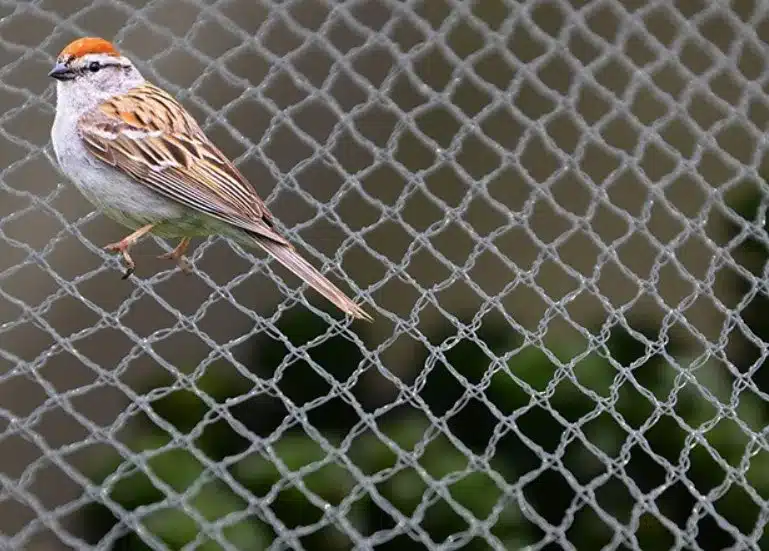
Anti-Bird Netting Mesh
3. Price
Price is another important consideration, especially for growers with larger plots. In the U.S. retail market, bird netting typically ranges from $0.01 to $0.06 per square foot, depending on the material, mesh density, and whether it includes UV protection. While cheaper netting might seem appealing, it often comes with trade-offs in strength and lifespan. For commercial farms or repeat seasonal use, buying in bulk or directly from agricultural netting manufacturers is usually more cost-effective in the long run.
4. UV resistance
Finally, don’t overlook durability and UV resistance. Since blueberry netting stays outside for weeks or even months, it must withstand sun exposure, wind, and rain. Nets with built-in UV stabilizers are far less likely to become brittle or tear over time. If you’re investing in a reusable system, look for nets with reinforced edges or knotless woven designs—they tend to last longer and hold up better in tough conditions.
Blueberry Netting Ideas for Small-scale or Home Use
Now that you’ve chosen the right blueberry netting, it’s time to talk about how to set it up effectively, whether you’re covering a few bushes in your backyard or managing a large orchard.
The good news is that most netting types—whether for birds, insects, or sun—can be installed using similar structures. What differs is the scale, material strength, and how much access you need to your plants. In this section, we’ll walk you through a few practical netting setup ideas. Whether you’re a DIY gardener or a commercial grower, you can borrow these approaches and adapt them to fit your space and budget.
1. Using Garden Stakes and Netting:
Before starting, you will need garden stakes made of wood, bamboo, or more durable materials like PE, aluminum, or iron. You will also need netting, garden pins, and stones.
First, measure the area around your blueberry bushes to determine how many stakes you will need and how much netting is required to cover the entire area. Next, insert the garden stakes into the ground at the corners and mid-points of the area you want to protect. Make sure the stakes are firmly anchored in the ground and are tall enough to cover the height of the bushes.
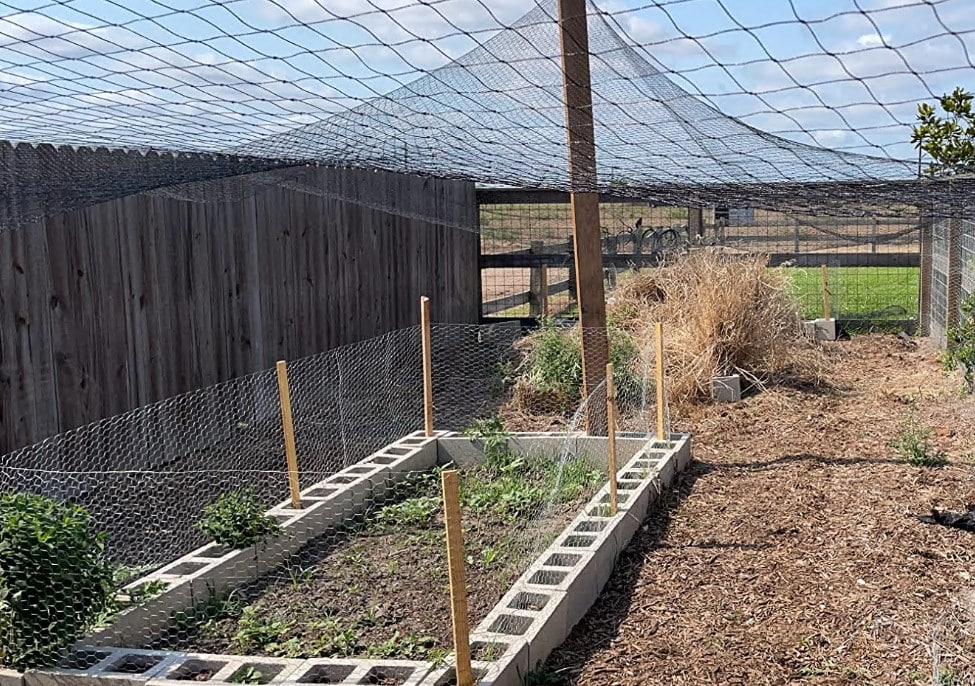
HDPE bird netting
Once the stakes are in place, drape the netting over them, creating a barrier that covers the entire area, including the top and sides. Secure the netting at the bottom with garden pins or stones to prevent birds and pests from accessing the bushes from underneath. Check for any gaps or openings in the netting and close them off.
Remember to lift the netting when you need to access the bushes for maintenance or harvesting, and then secure it again afterward. This method is cost-effective and can be easily adjusted or expanded as your blueberry bushes grow.
2. PVC Pipe Frame
A PVC pipe frame is a durable and cost-effective solution for protecting your blueberries from birds and pests. To build a PVC pipe frame, you will need PVC pipes, PVC connectors (elbows and tees), a saw or pipe cutter, and netting.
First, measure and cut the PVC pipes to fit the dimensions of your blueberry bushes. Assemble the pipes and connectors to create a frame that covers the entire bush. Make sure the frame is sturdy and stands well on its own.
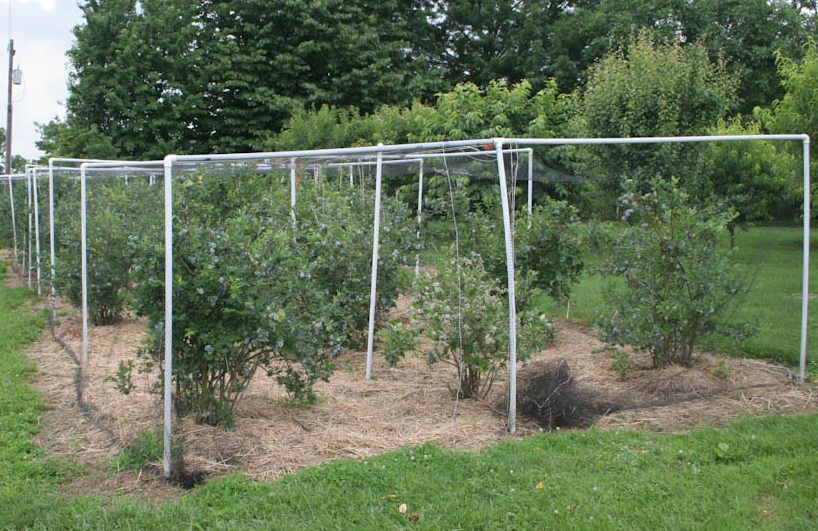
PVC pipe frame blueberry netting structure – uky.edu
Next, drape the netting over the frame, ensuring it covers all sides and reaches the ground. Secure the netting at the bottom with garden pins, stones, or by burying the edges in the soil. This will prevent birds and pests from accessing the bushes from underneath. Remember to lift the netting when you need to access the bushes for maintenance or harvesting, and then secure it again afterward.
3. Pop-up Netting Cage
Pop-up garden netting cages are a convenient and portable option for protecting your blueberries. These tents are available online or at garden centers and usually come with everything you need, including the frame, netting, and ground stakes.
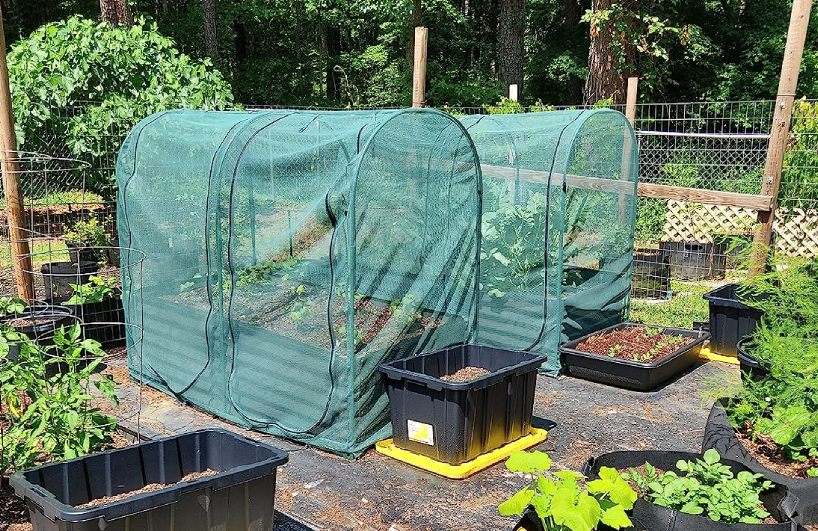
Portable pop-up garden netting for blueberry
To set up a pop-up netting tent, first, clear the area around your blueberry bushes of any debris or obstacles. Next, unfold the tent and extend it fully. Some tents may have poles that need to be assembled, so follow the manufacturer’s instructions. Position the tent over the blueberry bushes and secure it to the ground using the included ground stakes.
Make sure the netting covers the bushes completely and reaches the ground. Check for any gaps or openings that birds or pests could use to access the bushes and close them off. Pop-up netting tents can be easily moved or stored when not in use, making them a flexible solution for protecting your blueberries.
4 Video Tutorial
Blueberry Netting Strategies for Commercial Farms
For large-scale commercial blueberry farms, it is crucial to select netting that is durable for outdoor use. Additionally, when constructing the blueberry netting system, it is essential to pay attention to the overall stability of the structure. Below are some blueberry netting ideas tailored for commercial purposes:
1. Overhead Netting System
An overhead netting system involves installing poles around the perimeter and throughout the blueberry field, and then draping the netting over the top. This creates a canopy that protects the entire field from birds and other pests.
Poles must be secured using ground anchors or concrete foundations to ensure stability during adverse weather conditions. The advantage of this system is that, if the structure is high enough, it allows people and machinery to move freely underneath, facilitating maintenance, harvest, and other activities.
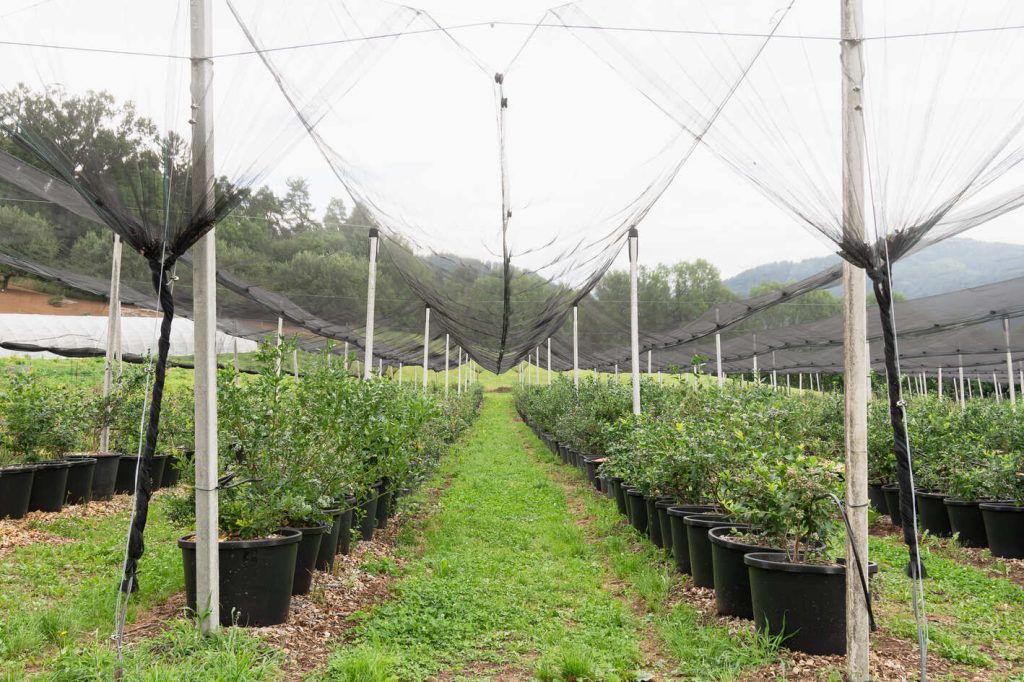
Overhead blueberry netting structure
Also, once the structure is built, it can be repurposed in the future. For example, the bird netting can be replaced with shade cloth to create a shade system quickly. While this system is highly effective, it may require a significant investment in terms of installation and materials. It is essential to use durable and UV-resistant netting materials
2. Drap Over Netting System
Drape over netting involves draping the netting directly over blueberry bushes in rows. This technique is effective in preventing birds, pests, and insects from accessing the bushes. As blueberry drape netting isn’t very high, it’s less difficult to install, making it more cost-effective than overhead netting, but it may not be as convenient for bush maintenance and harvesting.
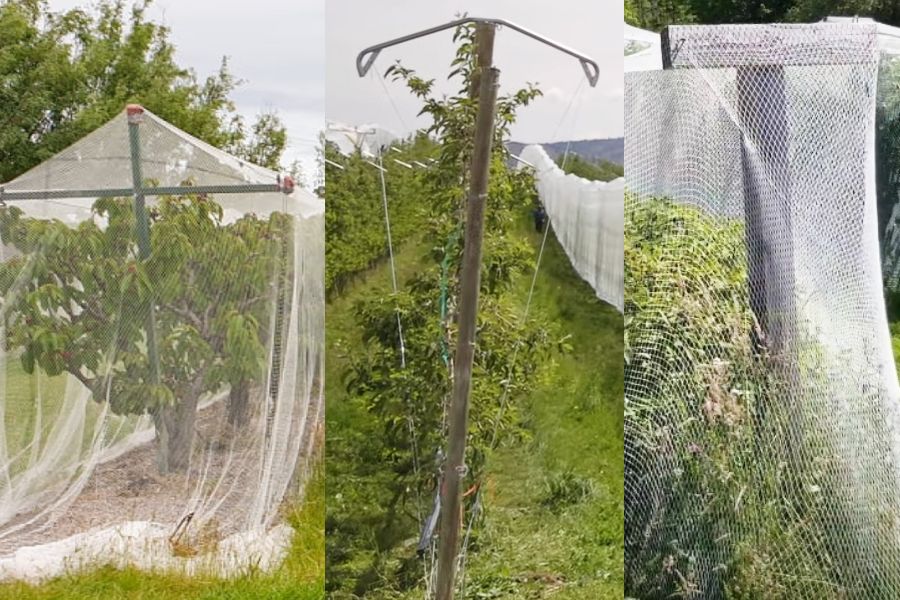
Draped netting support
For installation, first measure the area and number of blueberry bush rows to determine the appropriate netting width, length, and quantity of poles and other accessories needed. Then, install the support system by placing poles at regular intervals along the row and connecting them with steel wire ropes or brackets. Lastly, hang the net on the support system and secure its edges and connection points with ropes or connectors. Adjust the net to cover the entire protection area. For larger areas, net spreading machines can improve efficiency.
3. Hoop-Frame Netting System
The Hoop-Frame Netting System, inspired by common greenhouse structures, is a versatile and stable option for large-scale commercial blueberry farms. This system entails creating a series of hoop frames over the blueberry bushes, followed by draping bird or insect netting over these frames. The hoops can be crafted from durable materials such as galvanized steel or PVC, which can be conveniently acquired from commercial greenhouse manufacturers and assembled using their provided tutorials. This not only ensures protection from birds and pests but also offers a shield against harsh weather conditions.
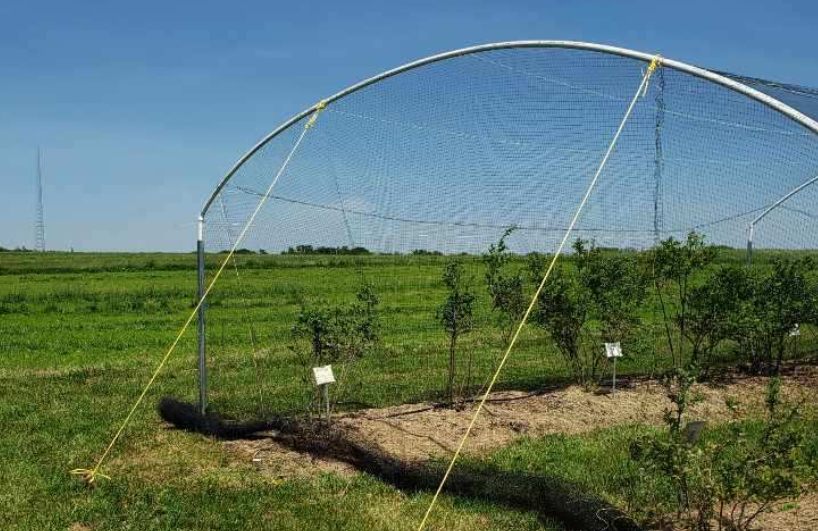
Hoop-frame net structure for blueberry trees – missouristate.edu
One of the significant advantages of this system is its stability against wind and other weather elements, compared to simpler drape-over systems. It also allows for easier maintenance and harvesting due to its accessibility. Moreover, its versatile nature means it can serve multiple purposes; for instance, during the offseason, the netting can be replaced with a plastic cover to create a greenhouse effect for young plants or to extend the growing season.
FAQs
1. When to install blueberry nets?
The best time to install blueberry nets is during the flowering stage of the bushes, which typically occurs in the spring season, around April to May in the Northern Hemisphere. This is when the bushes need protection from strong winds and heavy rains. As the berries ripen, usually from May to July, birds and pests like blueberry fruit flies and maggots become a significant threat. Covering the bushes with netting at this stage keeps the birds and pests away, ensuring a bountiful harvest.
2. How can I maintain and clean the blueberry nets?
Regularly check the netting for any signs of wear or damage. Clean the nets after each harvest season by gently brushing off any debris and washing them with a mild detergent and water. Rinse thoroughly and let them dry completely before storing. This will help to ensure the netting remains effective and durable for the next season.
3. How should I store the blueberry nets to ensure their durability?
After cleaning and completely drying the nets, fold them neatly and store them in a cool, dry place, away from direct sunlight and sharp objects. This will help prevent the netting from deteriorating or getting damaged while in storage.
4. What can I use as a substitute if I don’t have blueberry nets?
If you don’t have blueberry nets, you can use other types of bird netting or garden netting with a mesh size of about 1.5 cm (1/2 inch) to prevent birds and pests from getting through but still allow sunlight, rain, and air circulation.
Additionally, reflective objects like aluminum foil strips or old CDs can be hung around your bushes to scare away birds. Visual bird scare devices like fake owls or predatory birds can also be used, as birds tend to avoid areas where they feel threatened.
Alternative Methods:
Audio devices playing recordings of predator birds or bird distress calls can be used to frighten birds away. If all else fails, mosquito nets can be used as a last resort, but they may not be as effective as the mesh size may be too small to allow adequate sunlight and rain to reach the plants, and the material may not be durable enough for outdoor use. Regardless of the method chosen, it is important to regularly check and secure the netting or alternative methods to ensure maximum protection for your blueberry bushes.
5. What precautions should I take when installing blueberry nets?
When installing blueberry nets, make sure to measure the area around your blueberry bushes accurately to determine how much netting is required. The netting should cover the entire area, including the top and sides of the bushes. Secure the netting at the bottom with garden pins or stones to prevent birds and pests from accessing the bushes from underneath. Check for any gaps or openings in the netting and close them off.
Also, remember to lift the netting when you need to access the bushes for maintenance or harvesting, and then secure it again afterward. This will help to ensure the most effective protection for your blueberries.
